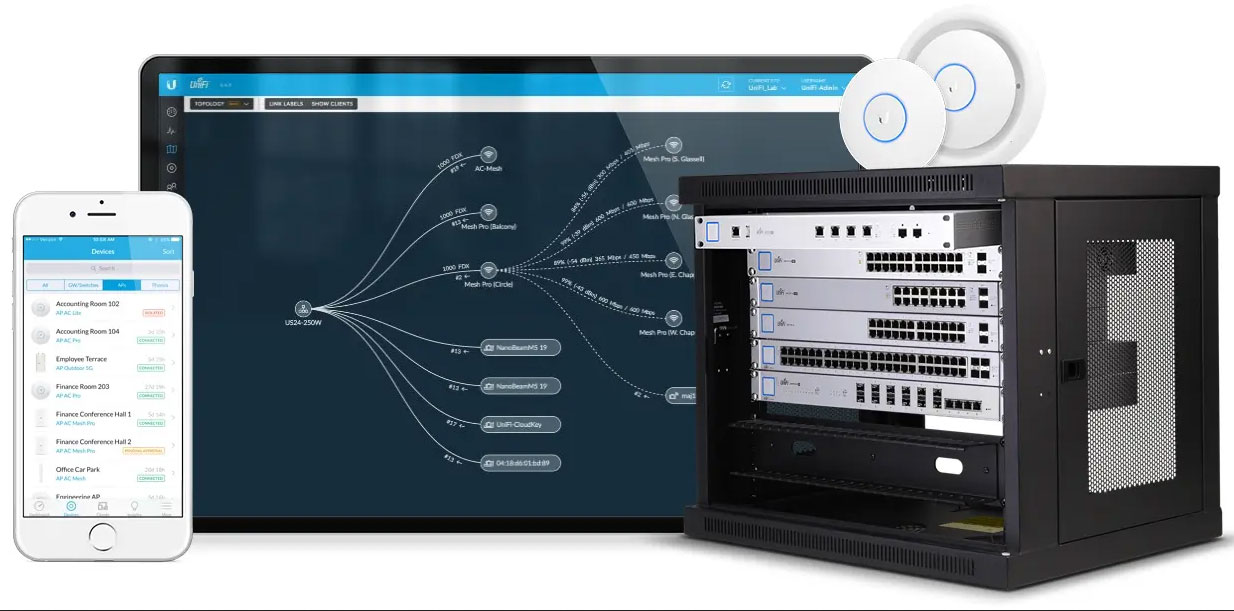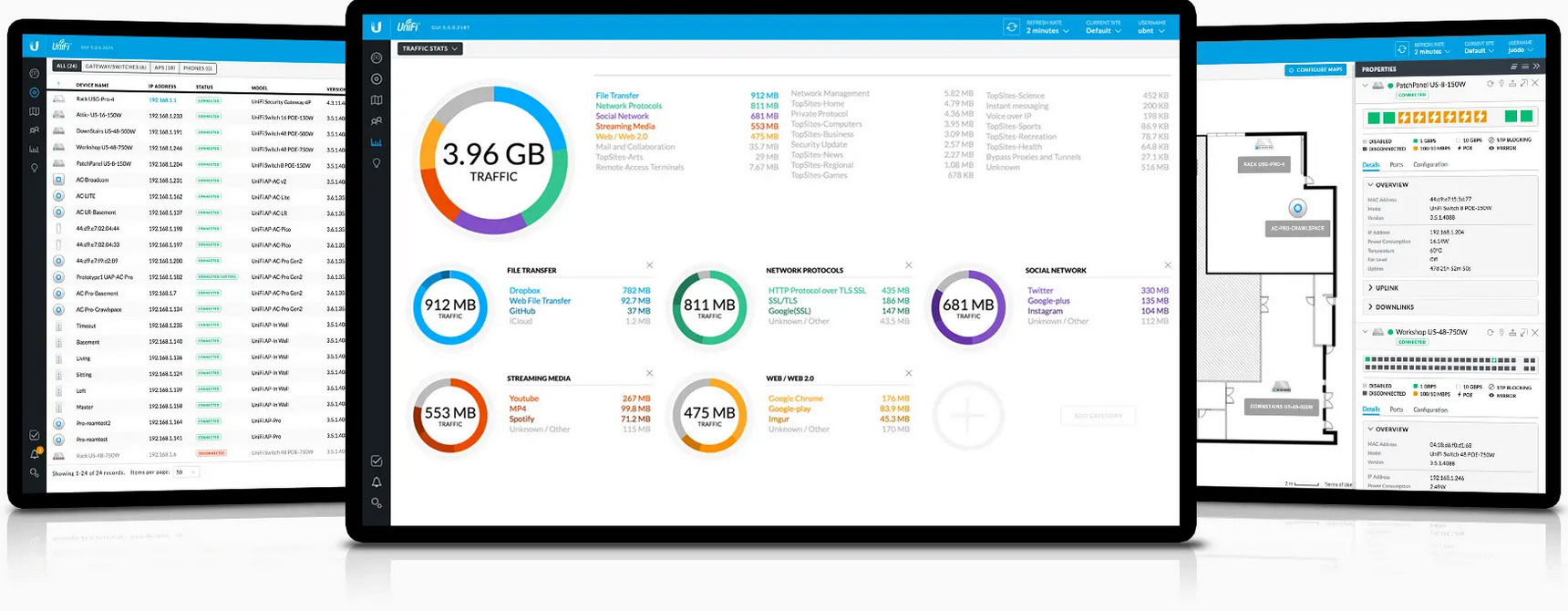Wifi Installation, Design and Planning
Design and Planning
Wi-Fi design and planning is crucial for businesses of all sizes, as it directly impacts the coverage, performance, and security of the network.
Coverage refers to the area in which a Wi-Fi signal is available and can be accessed by devices. Ensuring that the Wi-Fi network has adequate coverage is essential for businesses, as it enables employees and customers to stay connected and productive. Poor coverage can lead to dropped connections, slow speeds, and frustration for users. A proper Wi-Fi design and planning can ensure that the network covers all necessary areas and that signal strength is sufficient in those areas. This can be achieved through the use of wireless site surveys, which identify potential coverage issues and help to optimise the placement and configuration of access points.
Performance is another important aspect of Wi-Fi design and planning. A Wi-Fi network that experiences poor performance can lead to slow speeds, dropped connections, and other issues that can negatively impact productivity. Ensuring that the network is optimised for performance can help to minimise these issues and ensure that users have a positive experience. This can be achieved through the use of techniques such as load balancing, which helps to distribute network traffic evenly across multiple access points, and by using Quality of Service (QoS) to prioritise traffic.
Reliability is an essential aspect of Wi-Fi design and planning for businesses. A reliable Wi-Fi network ensures that users can consistently access the network and stay connected without interruption. By considering the number of devices that will be accessing the network, the types of applications that will be used, and the number and placement of access points, businesses can help to ensure that their Wi-Fi network is reliable. Additionally, using wireless site surveys, network monitoring tools, and other best practises can help to identify and resolve any issues that may be affecting the reliability of the network.
Security is also a critical aspect of Wi-Fi design and planning. Wi-Fi networks that are not properly secured can be vulnerable to attacks, which can compromise sensitive business information and lead to financial losses. Ensuring that the network is secure can help to minimise the risk of these types of incidents. This can be achieved through the use of techniques such as wireless encryption, which helps to protect the data that is transmitted over the network, and by implementing security protocols such as WPA2-Enterprise, which provides an additional layer of security for wireless connections.
Consider Devices Being Connected
When designing and planning a Wi-Fi network for a business, it is important to consider the types of devices that will be used on the network. Different types of devices have different requirements for connectivity, and understanding these requirements can help to ensure that the network is designed to support the needs of all devices.
For example, laptops and desktops typically have built-in wireless capabilities, and can connect to the network using standard Wi-Fi protocols such as 802.11b/g/n/ac. These devices typically require a stable connection and a high level of signal strength in order to function properly.
Mobile devices, such as smartphones and tablets, also have built-in wireless capabilities and can connect to the network using standard Wi-Fi protocols. However, they have different requirements than laptops and desktops, as they are typically used on the move and may need to switch between access points as they move around the building. Businesses should consider the number of mobile devices that will be used on the network and ensure that the network is designed to support the needs of these devices, such as providing consistent and stable connections even as the devices move around the building.
Another important factor to consider when designing a Wi-Fi network for a business is the number of IoT (Internet of Things) devices that will be used on the network. IoT devices include smart devices such as thermostats, security cameras, and other connected devices that are increasingly being used in businesses. These devices typically have lower requirements for connectivity and bandwidth than laptops, smartphones and tablets, but need to be considered when designing the network as they are often used in high number and can consume a significant amount of bandwidth. Businesses should ensure that the network is designed to handle the expected number of IoT devices and that the network is capable of providing stable connections for these devices as well.
Proper Installation
Having a Wi-Fi network installed and configured correctly is essential, as it ensures that the network is reliable, fast, and secure. A properly installed and configured Wi-Fi network can help to minimise issues and ensure that users have a positive experience.
One of the key reasons why it is important to have a Wi-Fi network installed and configured correctly is that it ensures that the network is reliable. A network that is not installed and configured properly can experience dropped connections, slow speeds, and other issues that can negatively impact productivity. By ensuring that the network is installed and configured correctly, businesses can help to minimise these issues and ensure that users have a stable and reliable connection.
Another reason why it is important to have a Wi-Fi network installed and configured correctly is that it ensures that the network is fast. A network that is not optimised for performance can experience slow speeds, which can negatively impact productivity. By ensuring that the network is installed and configured correctly, businesses can help to minimise issues and ensure that users have a fast and responsive connection.
A third reason why it is important to have a Wi-Fi network installed and configured correctly is that it ensures that the network is secure. A network that is not properly secured can be vulnerable to attacks, which can compromise sensitive business information and lead to financial losses. By ensuring that the network is installed and configured correctly, businesses can help to minimise the risk of these types of incidents and ensure that the network is secure.
Having a Wi-Fi network installed and configured correctly also means it will be able to handle the number of devices that need to connect, the types of applications that will be used, and the needs of IoT devices. It will also be able to provide coverage to all necessary areas, optimise the placement and configuration of access points, and balance the network traffic evenly across multiple access points.
WiFi Installation and Management with UniFi
WiFi for every size business
Ubiquiti UniFi wireless networking products are made to scale from small businesses, to large enterprises spanning multiple buildings and sites. Choosing Ubiquiti UniFi provides room for expansion while eliminating the worry of outgrowing your current system. Ubiquiti UniFi products maintain affordability, reliability and power no matter what your requirements may be.

UniFi your systems
Through the tools provided by Ubiquiti and their UniFi product range, it has never been easier to manage and maintain your WiFi infrastructure. Monitor traffic, map wireless coverage and connect your network across multiple sites. The UniFi platform is a one-step solution to a seriously amazing WiFi experience.


